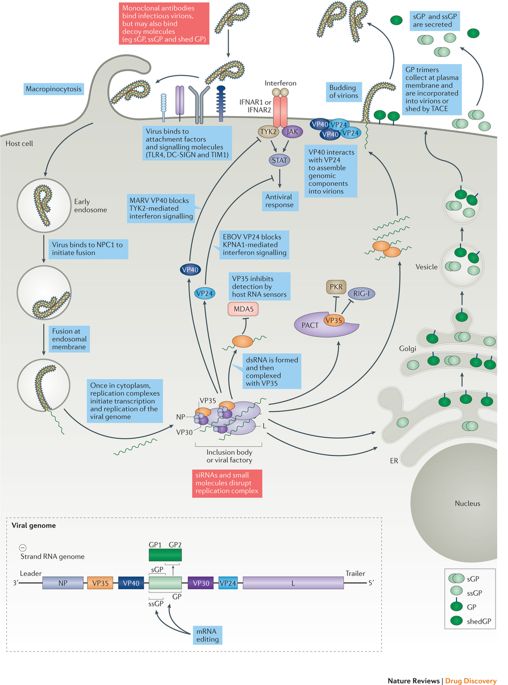Nature Reviews Drug Discovery ( IF 122.7 ) Pub Date : 2018-01-29 , DOI: 10.1038/nrd.2017.251 Robert W. Cross , Chad E. Mire , Heinz Feldmann , Thomas W. Geisbert

|
The filoviruses — Ebola virus and Marburg virus — cause lethal haemorrhagic fever in humans and non-human primates (NHPs). Filoviruses present a global health threat both as naturally acquired diseases and as potential agents of bioterrorism. In the recent 2013–2016 outbreak of Ebola virus, the most promising therapies for post-exposure use with demonstrated efficacy in the gold-standard NHP models of filovirus disease were unable to show statistically significant protection in patients infected with Ebola virus. This Review briefly discusses these failures and what has been learned from these experiences, and summarizes the current status of post-exposure medical countermeasures in development, including antibodies, small interfering RNA and small molecules. We outline how our current knowledge could be applied to the identification of novel interventions and ways to use interventions more effectively.
中文翻译:

埃博拉和马尔堡病毒感染的暴露后治疗
线状病毒(埃博拉病毒和马尔堡病毒)在人类和非人类灵长类动物(NHP)中引起致命的出血热。丝状病毒既是自然获得性疾病,又是生物恐怖主义的潜在媒介,对全球健康构成威胁。在最近的2013-2016年埃博拉病毒爆发中,暴露后使用的最有前途的疗法在金标准NHP线状病毒疾病模型中已证明具有疗效,但在感染埃博拉病毒的患者中未能显示出统计学上的显着保护作用。这篇综述简要讨论了这些失败以及从这些经验中学到的知识,并总结了暴露后医学对策发展中的现状,包括抗体,小分子干扰RNA和小分子。











































 京公网安备 11010802027423号
京公网安备 11010802027423号